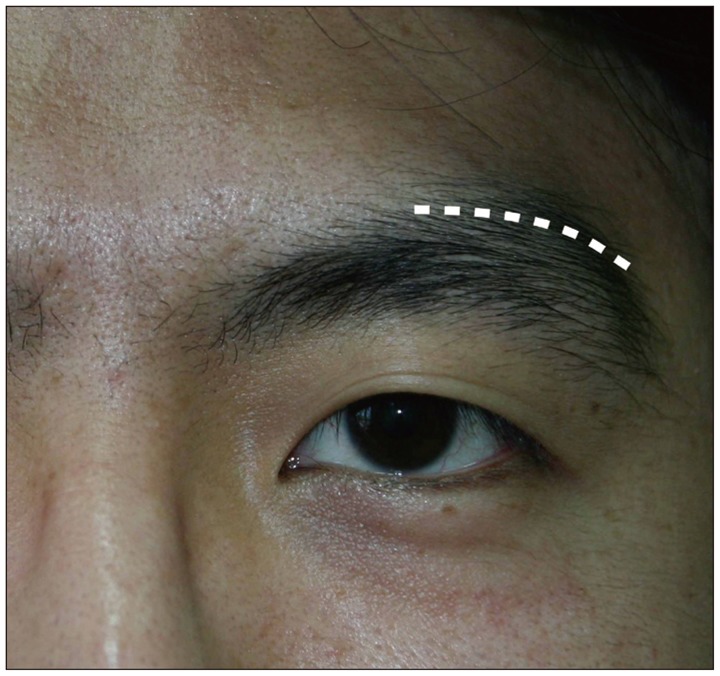Superciliary Keyhole Approach for Unruptured Anterior Circulation Aneurysms: Surgical Technique, Indications, and Contraindications
- Affiliations
-
- 1Department of Neurosurgery, Research Center for Neurosurgical Robotic Systems, Kyungpook National University, Daegu, Korea. jparkmd@hotmail.com
- KMID: 2018093
- DOI: http://doi.org/10.3340/jkns.2014.56.5.371
Abstract
- Neurosurgeons have been trying to reduce surgical invasiveness by applying minimally invasive keyhole approaches. Therefore, this paper clarifies the detailed surgical technique, its limitations, proper indications, and contraindications for a superciliary keyhole approach as a minimally invasive modification of a pterional approach. Successful superciliary keyhole surgery for unruptured aneurysms requires an understanding of the limitations and the use of special surgical techniques. Essentially, this means the effective selection of surgical indications, usage of the appropriate surgical instruments with a tubular shaft, and refined surgical techniques, including straightforward access to the aneurysm, clean surgical dissection, and the application of clips with an appropriate configuration. A superciliary keyhole approach allows unruptured anterior circulation aneurysms to be clipped safely, rapidly, and less invasively on the basis of appropriate surgical indications.
Keyword
MeSH Terms
Figure
Cited by 4 articles
-
Supraorbital Keyhole Approach for Intracranial Aneurysms : Transitioning from Concerns to Confidence
Jaechan Park
J Korean Neurosurg Soc. 2020;63(1):4-13. doi: 10.3340/jkns.2019.0042.Intradural Procedural Time to Assess Technical Difficulty of Superciliary Keyhole and Pterional Approaches for Unruptured Middle Cerebral Artery Aneurysms
Yeon-Ju Choi, Wonsoo Son, Ki-Su Park, Jaechan Park
J Korean Neurosurg Soc. 2016;59(6):564-569. doi: 10.3340/jkns.2016.59.6.564.Keyhole approach in anterior circulation aneurysm: Current indication, advantages, technical limitations, complications and their avoidance
Hanuman Prajapati, Ahmad Ansari, Manish Jaiswal
J Cerebrovasc Endovasc Neurosurg. 2022;24(2):101-112. doi: 10.7461/jcen.2022.E2021.07.008.Effects of Scalp Nerve Block on the Quality of Recovery after Minicraniotomy for Clipping of Unruptured Intracranial Aneurysms : A Randomized Controlled Trial
Seungeun Choi, Young Hoon Choi, Hoo Seung Lee, Kyong Won Shin, Yoon Jung Kim, Hee-Pyoung Park, Won-Sang Cho, Hyongmin Oh
J Korean Neurosurg Soc. 2023;66(6):652-663. doi: 10.3340/jkns.2023.0010.
Reference
-
1. Brydon HL, Akil H, Ushewokunze S, Dhir JS, Taha A, Ahmed A. Supraorbital microcraniotomy for acute aneurysmal subarachnoid haemorrhage : results of first 50 cases. Br J Neurosurg. 2008; 22:40–45. PMID: 17952722.
Article2. Chen L, Tian X, Zhang J, Huang Y, Chen E, Lan Q. Is eyebrow approach suitable for ruptured anterior circulation aneurysms on early stage : a prospective study at a single institute. Acta Neurochir. 2009; 151(Wien):781–784. discussion 784. PMID: 19424659.
Article3. Goh DH, Kim GJ, Park J. Medpor craniotomy gap wedge designed to fill small bone defects along cranial bone flap. J Korean Neurosurg Soc. 2009; 46:195–198. PMID: 19844617.
Article4. Lan Q, Gong Z, Kang D, Zhang H, Qian Z, Chen J, et al. Microsurgical experience with keyhole operations on intracranial aneurysms. Surg Neurol. 66(Suppl 1):2006; S2–S9. PMID: 16904991.
Article5. Mitchell P, Vindlacheruvu RR, Mahmood K, Ashpole RD, Grivas A, Mendelow AD. Supraorbital eyebrow minicraniotomy for anterior circulation aneurysms. Surg Neurol. 2005; 63:47–51. discussion 51. PMID: 15639524.
Article6. Paladino J, Mrak G, Miklić P, Jednacak H, Mihaljević D. The keyhole concept in aneurysm surgery--a comparative study : keyhole versus standard craniotomy. Minim Invasive Neurosurg. 2005; 48:251–258. PMID: 16320184.
Article7. Park J. Maintenance of cerebral blood flow during microsuture repair of the superior wall of the intracranial internal carotid artery. World Neurosurg. 2013; 80:436.e1–436.e5. PMID: 23563099.
Article8. Park J. Self-drilling anchor screws for dural tenting sutures : technical note. Surg Neurol. 2009; 72:175–176. PMID: 18617249.9. Park J, Hwang YH, Kim Y. Extended superciliary approach for middle cerebral artery embolectomy after unsuccessful endovascular recanalization therapy : technical note. Neurosurgery. 2009; 65:E1191–E1194. discussion E1194. PMID: 19934937.10. Park J, Jung TD, Kang DH, Lee SH. Preoperative percutaneous mapping of the frontal branch of the facial nerve to assess the risk of frontalis muscle palsy after a supraorbital keyhole approach. J Neurosurg. 2013; 118:1114–1119. PMID: 23432514.
Article11. Park J, Kang DH, Chun BY. Superciliary keyhole surgery for unruptured posterior communicating artery aneurysms with oculomotor nerve palsy : maximizing symptomatic resolution and minimizing surgical invasiveness. J Neurosurg. 2011; 115:700–706. PMID: 21699478.
Article12. Park J, Woo H, Kang DH, Sung JK, Kim Y. Superciliary keyhole approach for small unruptured aneurysms in anterior cerebral circulation. Neurosurgery. 2011; 68(2 Suppl Operative):300–309. discussion 309. PMID: 21346651.
Article13. Ramos-Zúñiga R, Velázquez H, Barajas MA, López R, Sánchez E, Trejo S. Trans-supraorbital approach to supratentorial aneurysms. Neurosurgery. 2002; 51:125–130. discussion 130-131. PMID: 12182409.
Article14. Reisch R, Perneczky A. Ten-year experience with the supraorbital subfrontal approach through an eyebrow skin incision. Neurosurgery. 2005; 57(4 Suppl):242–255. discussion 242-255. PMID: 16234671.
Article15. Shin D, Park J. Unruptured supraclinoid internal carotid artery aneurysm surgery : superciliary keyhole approach versus pterional appro-ach. J Korean Neurosurg Soc. 2012; 52:306–311. PMID: 23133717.
Article16. van Lindert E, Perneczky A, Fries G, Pierangeli E. The supraorbital keyhole approach to supratentorial aneurysms : concept and technique. Surg Neurol. 1998; 49:481–489. discussion 489-490. PMID: 9586924.
- Full Text Links
- Actions
-
Cited
- CITED
-
- Close
- Share
- Similar articles
-
- Unruptured Supraclinoid Internal Carotid Artery Aneurysm Surgery : Superciliary Keyhole Approach versus Pterional Approach
- Keyhole approach in anterior circulation aneurysm: Current indication, advantages, technical limitations, complications and their avoidance
- Aneurysm Surgery Using the Superciliary Keyhole Approach
- Keyhole Approach and Neuroendoscopy for Cerebral Aneurysms
- Intradural Procedural Time to Assess Technical Difficulty of Superciliary Keyhole and Pterional Approaches for Unruptured Middle Cerebral Artery Aneurysms






